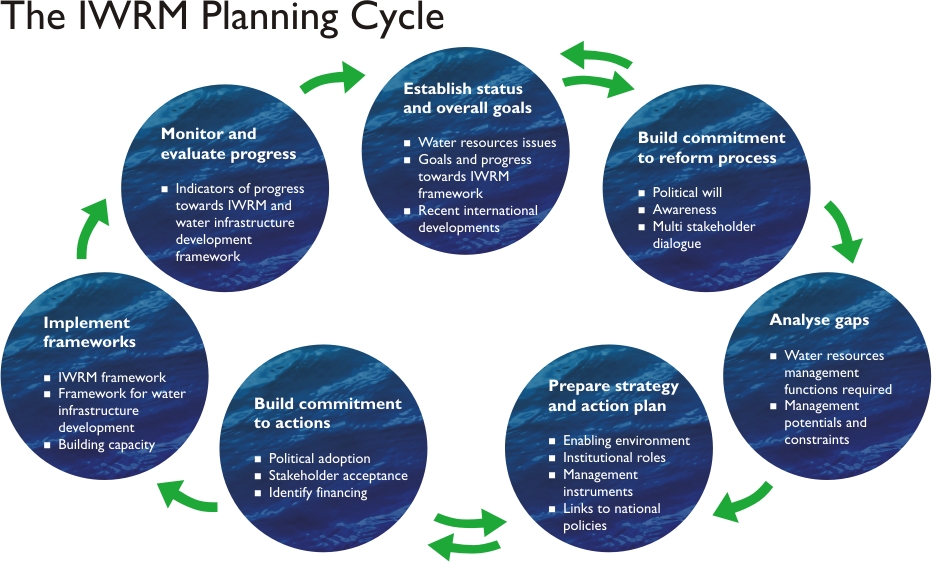Integrated Water Resources Management: A new approach for managing water
Welcome back! In my last blog post I discussed
some of the negative impacts associated with large scale water projects,
specifically dam construction whereby social and environmental factors were considered
inferior to economic ones. This approach is considered to be unsustainable
because these concerns were not given equal treatment and has since given rise to
the concept of Integrated Water Resources Management (IWRM).
What is IWRM
The Global
Water Partnership define IWRM as “… a process which promotes the coordinated
development and management of water, land and related resources in order to
maximise economic and social welfare in an equitable manner without compromising
the sustainability of vital ecosystems”. This approach is a direct response to
the top-down methods used previously and also addresses the issue of different
sectors acting independently from one another. Principles for this approach
were developed at the International Conference on Water and the Environment in
Dublin, Ireland in 1992 and are referred to as the Dublin principles. They are
as follows:
- Fresh water is a finite and vulnerable resource, essential to sustain life, development and the environment.
- Water development and management should be based on a participatory approach, involving users, planners and policy-makers at all levels.
- Women play a central part in the provision, management and safeguarding of water.
- Water has an economic value in all its competing uses and should be recognised as an economic good.
 |
| IWRM planning cycle |
Further to this, IWRM is considered to be a process
rather than a one-off project which is achieved through; developing appropriate
policies strategies and legislation; setting up the institutional framework from
which policies, strategies and legislation can be implemented; and setting up
management tools to carry out the implementation. Additionally, implementing this
approach is site specific meaning not one administrative model will work in all
places and needs to be adapted to each case in order to be effective.
Implementation of IWRM is largely done by two
organisations, the first being the Global Water Partnership (GWP) and the World
Water Council (WWC). These two organisations were created to give more
direction to achieving water related goals as previously they were divided between
many different organisations such as WMO, WHO, FAO, UNESCO, UNDP, UNED and UNICEF
(Savenije
& Van der Zaag, 2008).
Any criticisms..?
Although the concept of IWRM seemed to be openly
embraced particularly in Sub-Saharan Africa, there are some criticisms to the
approach. Mehta
(2015) outlines some of the issues with implementing IWRM in reality and how
it hasn’t always resulted in the best outcomes. Firstly, IWRM has become more
focused on the managerial and governance side of the process whilst deferring
probably the more critical issue facing Africa, which is increasing access to
water and enhancing water resources. This does not reflect accurately the
African context where poverty reduction and livelihood security is heavily correlated
with developing agriculture rather than focusing on management measures (Mehta,
2015).
In addition to this, Mehta (2015) argues that
IWRM has diverted attention from more serious issue such as "...land grabs, privatisation,
the negative impacts of water permits and a range of institutional ambiguities that
prevent water allocations to small and poor water users". IWRM tends to gloss
over the political realities of the implementation to seem more appealing. The
technical nature also appears to favour people with specialist knowledge on the
topic, potentially excluding particular stakeholders from effectively
participating. This technocratic dimension has been considered to be a form of
post-democratic governance whereby experts in the field hold the most authority
on the subject (Mehta 2015). Finally, the goals of integration is challenging
in itself and can often lead to conflicts between different water users who
have different needs for the same resource, such as water for agriculture vs
energy (Biswas
2004).
To conclude…
IWRM has become extremely popular over the last
few decades, particularly in Africa. It’s prominence can be attributed to ill-effects
of large scale, top down managed water projects which did not appropriately consider
social and environmental impacts in the decision making process. IWRM is seen
to rectify this imbalance between social, economic and environmental concerns,
however, has had some mixed results. The concept seems to be to vague to match
the complexities surrounding political actualities and methods for implementing
it have not always been appropriate for the area, particularly in Africa where
there are different needs than other parts of the world.
Thank you for reading!
Comments
Post a Comment